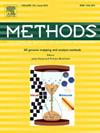环状化增强RNA适体结合和稳定性:来自细胞内核磁共振的证据
IF 4.3
3区 生物学
Q1 BIOCHEMICAL RESEARCH METHODS
引用次数: 0
摘要
RNA适体因其高特异性和低免疫原性而成为一种很有前途的分子探针。然而,它们的临床潜力往往受到生理条件下不稳定性的限制,主要是由于核外溶降解和结构灵活性。为了在模型系统中解决这些挑战,我们设计了一个针对HIV-1 Tat蛋白的环状RNA适体。利用T4 RNA连接酶对适体进行酶环化,并通过迁移率转移实验和RNase R酶切证实了环化。结合亲和性通过滤点印迹法评估,结构稳定性通过1D亚质子核磁共振和CLEANEX-PM实验评估。转染到HeLa细胞后,使用细胞内核磁共振监测细胞内稳定性。在我们的研究中,圆形适配体的结合亲和力比其线性适配体高约10倍,这是通过过滤结合实验确定的。核磁共振分析表明,它能提高结构刚性,保持天然碱基对,减少溶剂交换。值得注意的是,细胞内核磁共振显示,圆形适配体在转染后18小时内仍然可检测到,而线性适配体在几小时内降解。在这个系统中,环状化大大提高了RNA适配体的结合性能和细胞内持久性。这些发现证明了应用RNA循环增强活细胞适体功能的可行性,并为未来的治疗探索奠定了基础。本文章由计算机程序翻译,如有差异,请以英文原文为准。
Circularization enhances RNA aptamer binding and Stability: Evidence from in-cell NMR
RNA aptamers are emerging as promising molecular probes due to their high specificity and low immunogenicity. However, their clinical potential is often limited by instability under physiological conditions, primarily due to exonucleolytic degradation and structural flexibility. To address these challenges in a model system, we designed a circular RNA aptamer targeting the HIV-1 Tat protein.
Enzymatic circularization of the aptamer was performed using T4 RNA ligase, and circularization was confirmed by mobility shift assays and RNase R digestion. Binding affinity was assessed via filter dot blot assay, while structural stability was evaluated using 1D imino proton NMR and CLEANEX-PM experiments. Intracellular stability was monitored using in-cell NMR following transfection into HeLa cells.
In our study, the circular aptamer showed approximately tenfold higher binding affinity compared to its linear counterpart, as determined by filter binding assay. NMR analysis indicated improved structural rigidity, preservation of native base pairing, and reduced solvent exchange. Notably, in-cell NMR revealed that the circular aptamer remained detectable up to 18 h post-transfection, whereas the linear aptamer degraded within a few hours.
In this system, circularization substantially improved the binding performance and intracellular persistence of the RNA aptamer. These findings demonstrate the feasibility of applying RNA circularization to enhance aptamer functionality in living cells and lay the groundwork for future therapeutic exploration.
求助全文
通过发布文献求助,成功后即可免费获取论文全文。
去求助
来源期刊

Methods
生物-生化研究方法
CiteScore
9.80
自引率
2.10%
发文量
222
审稿时长
11.3 weeks
期刊介绍:
Methods focuses on rapidly developing techniques in the experimental biological and medical sciences.
Each topical issue, organized by a guest editor who is an expert in the area covered, consists solely of invited quality articles by specialist authors, many of them reviews. Issues are devoted to specific technical approaches with emphasis on clear detailed descriptions of protocols that allow them to be reproduced easily. The background information provided enables researchers to understand the principles underlying the methods; other helpful sections include comparisons of alternative methods giving the advantages and disadvantages of particular methods, guidance on avoiding potential pitfalls, and suggestions for troubleshooting.
 求助内容:
求助内容: 应助结果提醒方式:
应助结果提醒方式:


